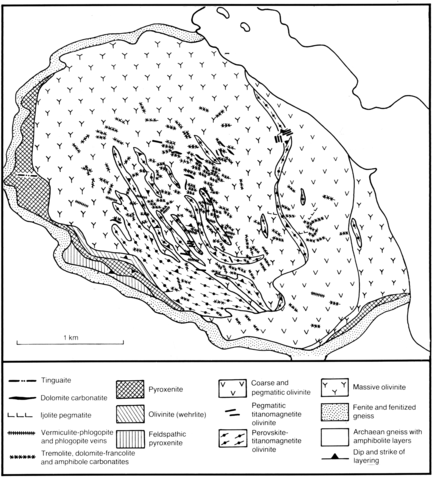stripes
This complex lies along the western margin of Seid lake and is situated in an upland part of an east-west-trending ridge. It is oval in outline and has an area of about 9 km2. The intrusion is composed largely of fine-, medium- and coarse-grained olivinites, which occupy 85-90% of the area of the complex, that are enriched in titanomagnetite and display a well-pronounced banding. Coarse-grained olivinites which do not contain ore minerals form an arcuate body of about 2 km2 on the eastern side of the complex. They are younger than the ore-bearing olivinites, as demonstrated by cross-cutting relationships with banding defined by ore-rich layers in the fine- and medium-grained olivintes. On the western, southwestern and southern margins of the complex the olivinites are rimmed by clinopyroxenites, into which they grade gradually through a zone of olivine clinopyroxenites (wherlites). In the immediate vicinity of the outer contact the pyroxenites contain orthoclase. In the central part of the complex dykes are widespread and include ijolite pegmatite, tinguaite and alkaline and cancrinite syenite. Postmagmatic veins include tremolite, clinohumite-tremolite, phlogopite, phlogopite-vermiculite, serpentine-hornblende, serpentine-tremolite-dolomite rocks, carbonatites and serpentine veins. Among the carbonatites, apatite-dolomite types, with which rare earth mineralization is associated, and monomineralic dolomite carbonatites are distinguished. Apart from the predominant dolomite and fluorapatite the carbonatites also contain tremolite, hydro-phlogopite, biotite and, as secondary minerals, calcite, quartz, magnetite, hydro-goethite, pyrrhotite, pyrite, titanite and accessory pyrochlore, natroniobite, zircon, dysanalyte, lueshite and phosphates, carbonates and fluocarbonates of rare earths. Three mineral associations, corresponding to three stages of carbonatite evolution, have been distinguished by Kukharenko et al. (1965). These are (a) zircon-apatite-dolomite, (b) pyrochlore-dolomite and (c) quartz-limonite with secondary phosphates and carbonates of rare earth elements. The gneisses into which the complex is emplaced are fenitized adjacent to the contacts.
KUKHARENKO, A.A., ORLOVA, M.P., BULAKH, A.G., BAGDASAROV, E.A., RIMSKAYA-KORSAKOVA, O.M., NEPHEDOV, E.I., IL'INSKII, G.A., SERGEEV, A.S. and ABAKUMOVA, N.B. 1965. The Caledonian complex of ultrabasic alkaline rocks and carbonatites of the Kola peninsula and north Karelia. Nedra, Moscow. 772 pp.

